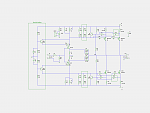Yeah, my first blog entry !

I have spent whole day in matching output transistors for poweramp I'm building for a friend.
I found out that Vbe tracks gain pretty good (the transistors with higher gain have proportionally higher Vbe), so I think the painful matching of Vbe at various collector currents is pretty much useless because Vbe spread can be already seen in DC current gain.
If I think of Vbe tracking gain, it is good, because transistor that needs more Vbe will be less opened, but it has higher gain, so collector current will be more equal between devices.
I have 10 pairs of MJ21193 / MJ21194 and plan to use 4 pairs per channel.
Transistors are ordered directly from Onsemi and the NPN's all come from the same batch but PNP's are from 2 different batches and that can be clearly seen from measurements because there is a big mismatch in gain between the 2 batches.
Fortunately, the ones from the same batch are pretty...















 . I printed and made the boards, drilled the holes and lacquered them. Couple of hours later they were ready for soldering the components.
. I printed and made the boards, drilled the holes and lacquered them. Couple of hours later they were ready for soldering the components.